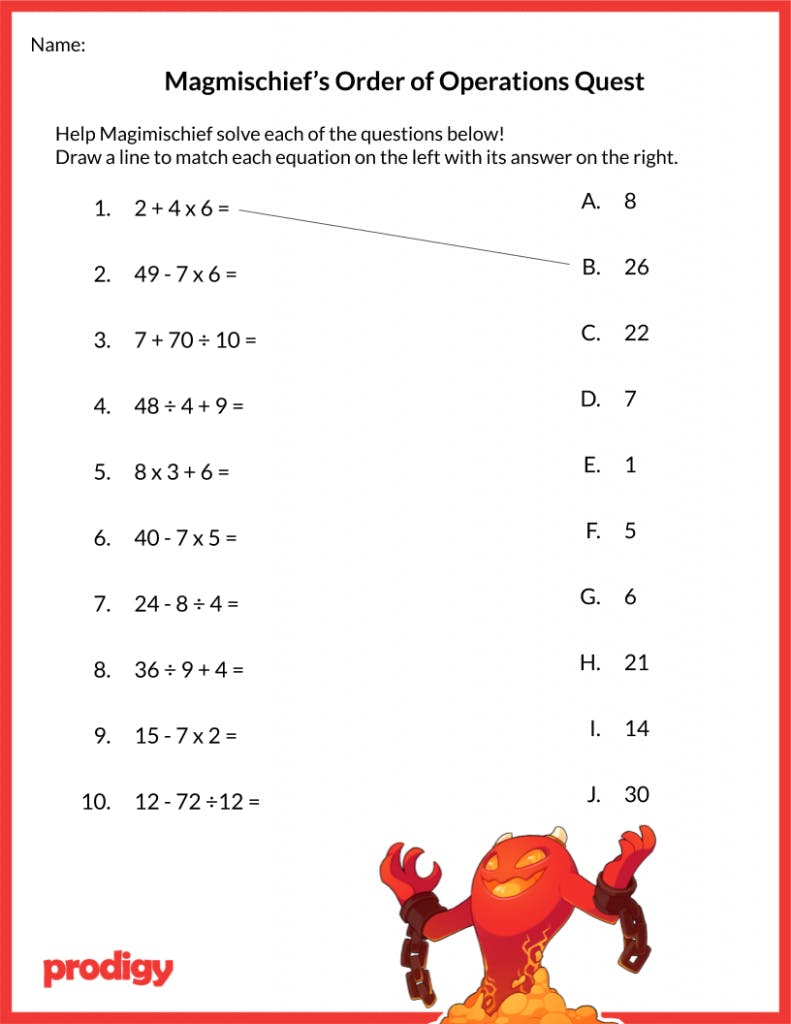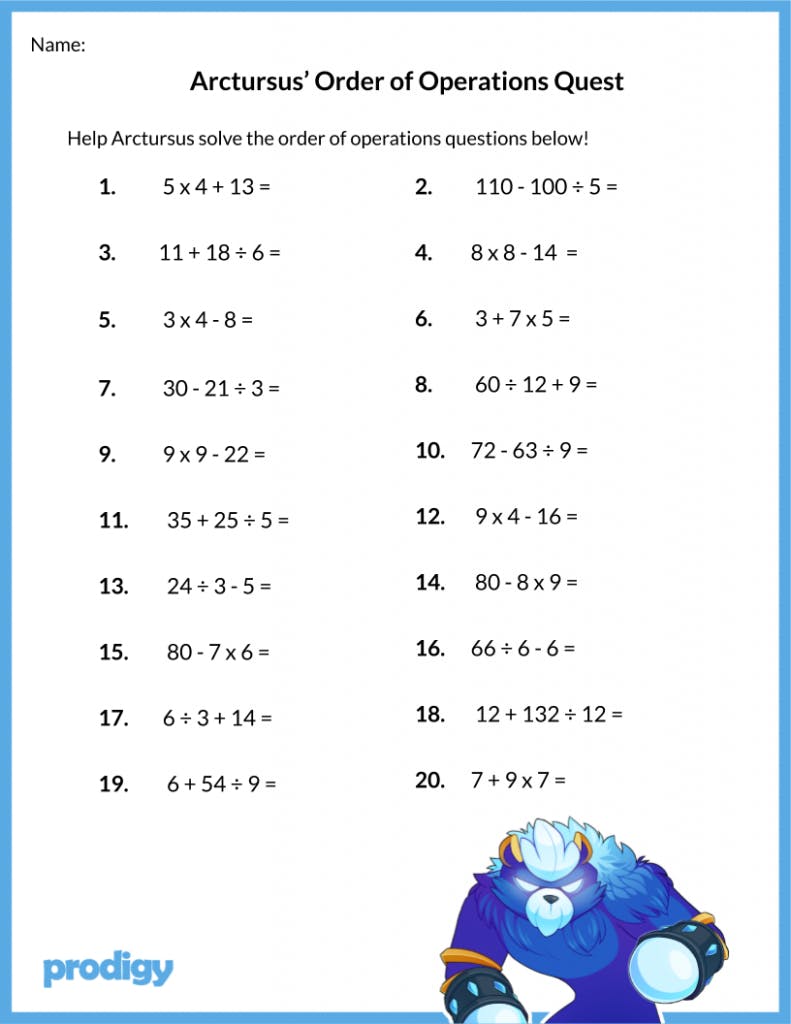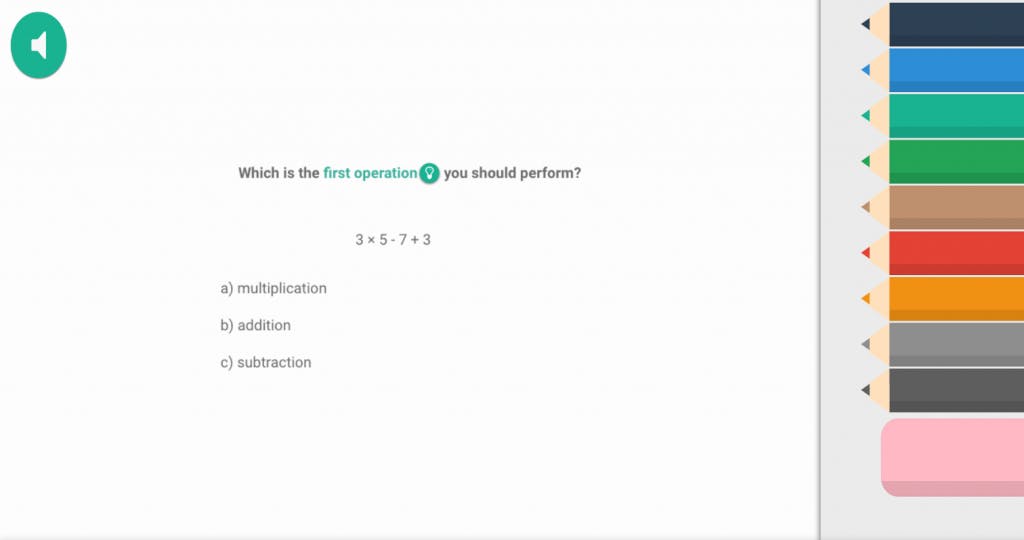Order of Operations Worksheet: 19 Resources For Your Class
All Posts
Written by Maria Kampen
Category
- Teacher Resources
- Teaching Tools
Contents
You’ve covered fractions, multiplication, long division and exponents. Now it’s time to put it all together with an order of operations worksheet.
Worksheets are one of the most widely-used methods for making sure students have opportunities to practice what they’re learning in the classroom. Use an order of operations practice worksheet to make sure your students have the skills they’ll need to confidently tackle higher-level math classes.
We’ve created a collection of fun worksheets to help students practice order of operations across grade levels. All of our worksheets come with answer keys and are available as an individual order of operations worksheet PDF for easy downloading and printing. They also feature Prodigy Epics your students will love!
Let’s get started!
Order of operations worksheet
Giving your students an order of operations worksheet is one of the most tried-and-true ways to help them develop their math skills. We’ve created a collection of worksheets to help your students understand the order of operations.

Are your students tired of math worksheets?
Prodigy helps you deliver differentiated and engaging order of operations practice for all your students!
See how it worksEasy order of operations worksheet without parentheses or exponents
These worksheets are perfect for students who are just learning about the order of operations. Start students off with familiar concepts of division, multiplication, addition and subtraction before adding parentheses and exponents.
When students get familiar with the order of operations at an earlier grade level, they’re more likely to understand the basic concepts once more complicated elements are added.


Order of operations worksheet without exponents
Adding parentheses to an equation gives mathematicians the ability to decide which operations come first. For example:
(2 + 3) x 5
Since 2 and 3 are inside the parentheses, they get added before performing the multiplication.
(5) x 5 = 25
These worksheets start with smaller numbers to get students comfortable using parentheses before moving on to larger numbers. This will ensure students completely understand how to use the order of operations before they move on to more complicated questions.
Advanced order of operations worksheet
Use an order of operations worksheet in your 7th or 8th grade classroom, or as a review for early high school students. These worksheets include short and long equations with a variety of different concepts, including an order of operations with integers worksheets, as well as other worksheets that combine PEMDAS with fractions and nested parentheses.
Students can use these worksheets to combine what they’ve learned in other units with the order of operations.
If you need to, review exponent rules with your class (and use our exponent rules worksheet!) before you get started.
How Prodigy makes order of operations engaging
What if you could make math class more exciting for you students?
Prodigy engages students, gives them time to practice key skills and provides actionable data for your classroom.
Use Prodigy to practice PEMDAS and keep students engaged with in-class content. Students will explore a world filled with education adventure, where success depends on successfully answering curriculum-aligned math questions.

They’ll battle monsters, collect cool pets and play with their friends, all while building essential math skills. With more than 1,400 skills across three DOK levels, you’ll be able to align in-game content with anything you’re teaching in the classroom — including the order of operations.
The game isn’t just effective for students, either! Teachers have access to a powerful dashboard that shows them how students are progressing through the curriculum and where students are struggling or excelling. You can also assign differentiated order of operations practice through our one-of-a-kind Plan, Assignment and Test Prep tools.
Here’s how:
What does the order of operations mean?

The order of operations tell mathematicians what steps they need to take when they’re solving a problem.
Because of the order of operations, equations are always solved the same way:
- Parentheses
- Exponents
- Multiplication and division
- Addition and subtraction.
You’ll notice multiplication and division are grouped as one step, as are addition and subtraction. That’s because they’re equal. Multiplication doesn’t come before division, and addition doesn’t come before subtraction (or vice versa). They’re worked at the same time, moving from left to right in an equation.
Let’s use this example:
20 ÷ 5 x 4
We don’t multiply first, because the division sign is closest to the left. 20 divided by 5 is 4, and 4 groups of 4 gives us our final answer of 16. If we were to multiply before we divide, we would end up with 1 as our answer, which is incorrect.
While the order of operations is most commonly used in math, it’s also an important part of certain computer programming languages.
PEMDAS and the order of operations

Since it’s important to remember the order of operations, there are lots of mnemonic devices for students to use. The most common is PEMDAS, which stands for Parentheses, Exponents, Multiplication and Division, Addition and Subtraction.
PEMDAS can also be remembered using the acronym “Please Excuse My Dear Aunt Sally.”
PEMDAS is the most common order of operations mnemonic in the United States, but it has a few different names around the world:
- In Canada and New Zealand, BEDMAS is the most common (Brackets, Exponents, Division and Multiplication, Addition and Subtraction)
- The UK uses BIDMAS (Brackets, Indices, Division and Multiplication, Addition and Subtraction)
- Other English-speaking countries like India and Australia use BODMAS (Brackets, Order, Division and Multiplication, Addition and Subtraction)
Even though they’re different names, they all mean the same thing!
When to use an order of operations worksheet
Try using these worksheets at the beginning of class, as an easy quiet time activity, or as part of a rotating learning station.
Worksheets are an effective way for students to practice new skills they’ve just learned, or to review skills that were taught in previous units or grades. You can also use worksheets to identify which students are struggling with particular concepts and might need extra help.
However you decide to use these order of operations worksheets, they’ll be a valuable resource for you and your students!
Start teaching order of operations with Prodigy today. Prodigy is a fun and engaging curriculum-aligned game-based learning platform that encourages students to love learning math. With more than 2.5 million teachers and 90 million students, Prodigy offers unique solutions for your classroom.



